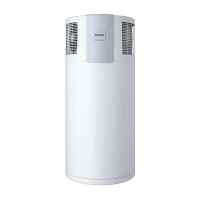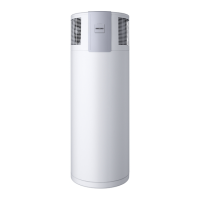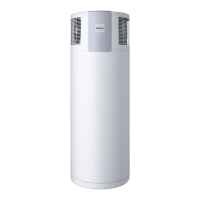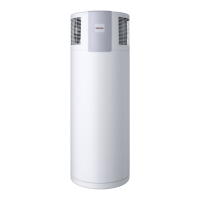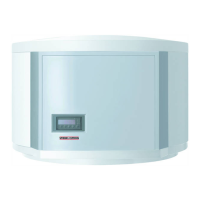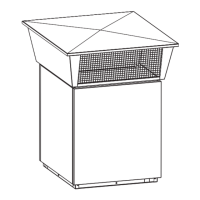OPERATION
Maintenance and care
www.stiebel-eltron.com WWK 223-303 electronic | 13
ENGLISH
Manual emergency heating mode
If a fault has occurred and no fault code is displayed, you can
activate emergency heating mode.
Keep the “Plus” and “Minus” buttons
pressed. In addition, press the “Menu”
button and keep all three buttons
pressed for 5seconds.
The “electrical emergency/booster heat-
er” symbol appears. Service/fault symbol
flashes.
4.5 Emergency shutdown
In the event of an emergency, carry out the following steps:
f Disconnect the power supply at the fuse/MCB in the domestic
distribution board.
f Shut off the cold water supply.
f Immediately notify a qualified contractor, as the appliance
is not protected against corrosion while the power supply is
interrupted.
5. Maintenance and care
WARNING Electrocution
Only clean the exterior of the appliance.
Never open the appliance.
Do not insert objects through the grille into the interior
of the appliance.
Never spray the appliance with water.
Never spray water into the appliance.
!
WARNING Injury
Maintenance work, such as checking electrical safety,
must only be carried out by a qualified contractor.
Appliance compo-
nents
Care and maintenance tips
Casing Use a damp cloth to clean the casing sections. Never
use abrasive or corrosive cleaning agents.
Air intake grille / air
discharge grille
Clean the air intake grille and air discharge grille
every six months. Cobwebs or other kinds of contami-
nation can restrict the air supply to the appliance.
DHW cylinders
The DHW cylinder is equipped with a mainte-
nance-free impressed current anode to safeguard
it against corrosion. The power supply must not be
interrupted while the appliance is filled with water to
enable the impressed current anode to provide pro-
tection. Otherwise there is a risk of corrosion.
Electric emergency/
booster heater
Have the electric emergency/booster heater descaled
from time to time. This will extend the service life of
the electric emergency/booster heater.
appliance Have the safety assembly and the evaporator checked
regularly by a qualified contractor.
Condensate drain
Undo the condensate drain. Check that the condensate
drain is clear and remove any dirt from the conden-
sate drain connection of the appliance.
6. Troubleshooting
Problem Cause Remedy
The compressor
is operational,
but the fan is
off.
If the appliance is in defrost
mode, the fan may not switch
on again until the maximum
defrost time has been ex-
ceeded. The defrosting pro-
cess is shown on the display.
No action required. A max-
imum defrost time is set in
the appliance. If, despite
the defrost, the defrost end
temperature is not reached
within the maximum defrost
time, a fault code appears.
Please consult a qualified
contractor.
No hot water is
available.
No power at the appliance.
Check that the appliance
is connected to the power
supply.
A fuse/MCB in the fuse box
has blown/tripped.
Check whether the fuses/
MCBs in your fuse box have
blown/tripped. If required,
disconnect the appliance from
the power supply and replace
the fuses/reset the MCBs.
Contact your qualified con-
tractor if the fuse/MCB blows/
trips again after the appliance
is re-connected to the power
supply.
The intake air temperature is
outside the application limits
(see "Specification/ Data
table" chapter). The compres-
sor was switched off/locked
automatically.
No action required. The ap-
pliance heats the water using
the electric emergency/boost-
er heater. As soon as the tem-
perature is back within the
application limits, the heating
process is continued with the
compressor.
The appliance output data are
calculated according to stand-
ard, using the intake temper-
ature specified in the data
table. Below this temperature
the appliance efficiency and
output decrease. The heat-up
time is extended.
No action required.
Activate runtime-dependent
rapid heat-up if required.
Increased energy expenditure
should be expected.
If the heat pump runtime is
very long, this may be due
to an excessively low intake
temperature.
No action required. Activate
runtime-dependent rapid
heat-up if required.
The set tem-
perature is not
achieved.
Subject to intake temperature
and hot gas temperature, the
appliance may temporarily
reduce the set temperature to
the actual value captured by
the integral sensor.
No action required. The ap-
pliance displays the "set tem-
perature adjustment" symbol
and blocks DHW heating
until the actual temperature
captured by the integral sen-
sor is below the temporary
set value by a value equal
to the reduced start hyster-
esis. DHW heating is then
re-enabled and the originally
selected set temperature is
again applied.
The safety valve
of the DHW
cylinder is drip-
ping.
The appliance cylinder is at
mains water pressure. During
the heat-up process, expan-
sion water will drip from the
safety valve.
If water continues to drip
when heating is completed,
please inform your qualified
contractor.
The condensate
drain drips.
The surface temperature of
the evaporator is lower than
the dew point temperature of
the ambient air. Condensate
forms.
The amount of condensate
depends on the humidity
level of the ambient air.
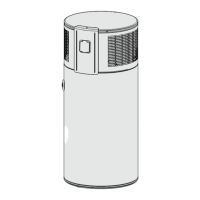
